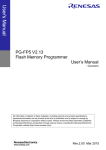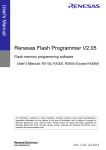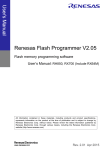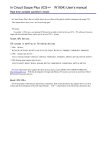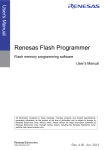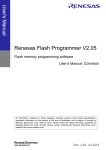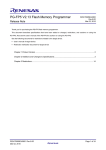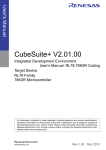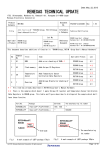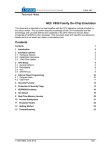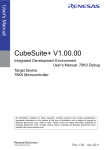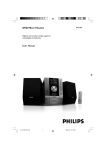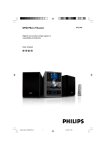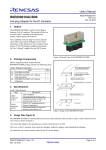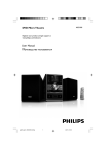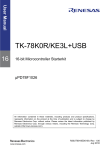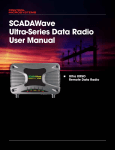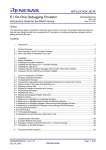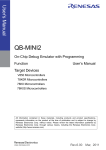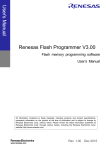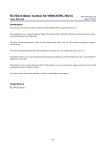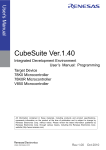Download Renesas Flash Programmer V2.05 Flash memory programming
Transcript
Renesas Flash Programmer V2.05
Flash memory programming software
User’s Manual: RL78, 78K, V850
All information contained in these materials, including products and product specifications,
represents information on the product at the time of publication and is subject to change by
Renesas Electronics Corp. without notice. Please review the latest information published by
Renesas Electronics Corp. through various means, including the Renesas Electronics Corp.
website (http://www.renesas.com).
Rev. 2.02 Jul 2015
Notice
1.
Descriptions of circuits, software and other related information in this document are provided only to illustrate the operation of
semiconductor products and application examples. You are fully responsible for the incorporation of these circuits, software,
and information in the design of your equipment. Renesas Electronics assumes no responsibility for any losses incurred by you
or third parties arising from the use of these circuits, software, or information.
2.
Renesas Electronics has used reasonable care in preparing the information included in this document, but Renesas Electronics
does not warrant that such information is error free. Renesas Electronics assumes no liability whatsoever for any damages
incurred by you resulting from errors in or omissions from the information included herein.
3.
Renesas Electronics does not assume any liability for infringement of patents, copyrights, or other intellectual property rights of
third parties by or arising from the use of Renesas Electronics products or technical information described in this document. No
license, express, implied or otherwise, is granted hereby under any patents, copyrights or other intellectual property rights of
Renesas Electronics or others.
4.
You should not alter, modify, copy, or otherwise misappropriate any Renesas Electronics product, whether in whole or in part.
Renesas Electronics assumes no responsibility for any losses incurred by you or third parties arising from such alteration,
modification, copy or otherwise misappropriation of Renesas Electronics product.
5.
Renesas Electronics products are classified according to the following two quality grades: “Standard” and “High Quality”. The
recommended applications for each Renesas Electronics product depends on the product’s quality grade, as indicated below.
“Standard”:
Computers; office equipment; communications equipment; test and measurement equipment; audio and visual
equipment; home electronic appliances; machine tools; personal electronic equipment; and industrial robots etc.
“High Quality”: Transportation equipment (automobiles, trains, ships, etc.); traffic control systems; anti-disaster systems; anticrime systems; and safety equipment etc.
Renesas Electronics products are neither intended nor authorized for use in products or systems that may pose a direct threat to
human life or bodily injury (artificial life support devices or systems, surgical implantations etc.), or may cause serious property
damages (nuclear reactor control systems, military equipment etc.). You must check the quality grade of each Renesas
Electronics product before using it in a particular application. You may not use any Renesas Electronics product for any
application for which it is not intended. Renesas Electronics shall not be in any way liable for any damages or losses incurred
by you or third parties arising from the use of any Renesas Electronics product for which the product is not intended by Renesas
Electronics.
6.
You should use the Renesas Electronics products described in this document within the range specified by Renesas Electronics,
especially with respect to the maximum rating, operating supply voltage range, movement power voltage range, heat radiation
characteristics, installation and other product characteristics. Renesas Electronics shall have no liability for malfunctions or
damages arising out of the use of Renesas Electronics products beyond such specified ranges.
7.
Although Renesas Electronics endeavors to improve the quality and reliability of its products, semiconductor products have
specific characteristics such as the occurrence of failure at a certain rate and malfunctions under certain use conditions. Further,
Renesas Electronics products are not subject to radiation resistance design. Please be sure to implement safety measures to
guard them against the possibility of physical injury, and injury or damage caused by fire in the event of the failure of a Renesas
Electronics product, such as safety design for hardware and software including but not limited to redundancy, fire control and
malfunction prevention, appropriate treatment for aging degradation or any other appropriate measures. Because the evaluation
of microcomputer software alone is very difficult, please evaluate the safety of the final products or systems manufactured by
you.
8.
Please contact a Renesas Electronics sales office for details as to environmental matters such as the environmental compatibility
of each Renesas Electronics product. Please use Renesas Electronics products in compliance with all applicable laws and
regulations that regulate the inclusion or use of controlled substances, including without limitation, the EU RoHS Directive.
Renesas Electronics assumes no liability for damages or losses occurring as a result of your noncompliance with applicable laws
and regulations.
9.
Renesas Electronics products and technology may not be used for or incorporated into any products or systems whose
manufacture, use, or sale is prohibited under any applicable domestic or foreign laws or regulations. You should not use
Renesas Electronics products or technology described in this document for any purpose relating to military applications or use
by the military, including but not limited to the development of weapons of mass destruction. When exporting the Renesas
Electronics products or technology described in this document, you should comply with the applicable export control laws and
regulations and follow the procedures required by such laws and regulations.
10. It is the responsibility of the buyer or distributor of Renesas Electronics products, who distributes, disposes of, or otherwise
places the product with a third party, to notify such third party in advance of the contents and conditions set forth in this
document, Renesas Electronics assumes no responsibility for any losses incurred by you or third parties as a result of
unauthorized use of Renesas Electronics products.
11. This document may not be reproduced or duplicated in any form, in whole or in part, without prior written consent of Renesas
Electronics.
12. Please contact a Renesas Electronics sales office if you have any questions regarding the information contained in this document
or Renesas Electronics products, or if you have any other inquiries.
(Note 1) “Renesas Electronics” as used in this document means Renesas Electronics Corporation and also includes its majorityowned subsidiaries.
(Note 2) “Renesas Electronics product(s)” means any product developed or manufactured by or for Renesas Electronics.
(2012.4)
How to Use This Manual
Target Readers
This manual is intended for users who are using the flash programmer in designing
and developing a system that employs a Renesas Electronics microcontroller
equipped with on-chip flash memory.
Purpose
This manual is intended to give users an understanding of the basic specifications
and correct use of the Renesas flash programmer.
Organization
This manual includes the following sections.
• Basic operation (Basic mode)
• Function details (Basic mode)
• Function details (Full mode)
• Script execution function
How to Read This Manual
It is assumed that the readers of this manual have general knowledge of electricity,
logic circuits, and microcontrollers.
Conventions
Note: Footnote for item marked with Note in the text.
Caution: Information requiring particular attention
Remark: Supplementary information
Numeral representation:
Binary ... xxxx or xxxxB
Decimal ... xxxx
Hexadecimal ... 0XXXXX or xxxxH
“
[
Related documents
”:
Any character or item on the screen that can be selected or input
:
Name of button
]:
Name of commands, dialog boxes, options, or areas on the screen
When using this manual, also refer to the following documents.
The related documents indicated in this publication may include preliminary versions.
However, preliminary versions are not marked as such.
Documents related to development tools
Document name
Document number
Renesas Flash Programmer V2.05 Common
R20UT2906E
Renesas Flash Programmer V2.05 RL78, 78K, V850
This manual
Renesas Flash Programmer V2.05 RX100, RX200, RX600 (Except RX64M)
R20UT2908E
Renesas Flash Programmer V2.05 RH850, RX700 (Include RX64M)
R20UT2909E
E1 Emulator R0E000010KCE00 E20 Emulator R0E000200KCT00
R20UT0398E
QB-MINI2 On-Chip Debug Emulator with Programming Function
R20UT0449E
MINICUBE2 Diagnosis Tool
U18588E
Caution
The related documents listed above are subject to change without notice.
Be sure to use the latest version of each document for designing, etc.
All trademarks and registered trademarks are the property of the respective owner.
CONTENTS
CHAPTER 1 BASIC OPERATION (BASIC MODE) .................................................... 6
CHAPTER 2 FUNCTION DETAILS (BASIC MODE)................................................. 14
2.1
2.2
Introduction ............................................................................................................................. 14
Starting up ............................................................................................................................... 14
2.2.1
[Welcome!] dialog box ............................................................................................. 15
2.2.2
[Create new workspace] dialog box ....................................................................... 16
2.2.3
[Communication Interface] dialog box ................................................................... 17
2.2.4
[Frequency] dialog box ............................................................................................ 18
4.2.5
[Power Supply] dialog box ...................................................................................... 21
2.2.6
[Project Settings] dialog box ................................................................................... 23
2.2.7
Open latest workspace ............................................................................................ 23
2.2.8
Open workspace ....................................................................................................... 24
2.3 Main Window ........................................................................................................................... 25
2.4 Menu Bar ................................................................................................................................. 26
2.4.1
[File] menu ................................................................................................................ 26
2.4.2
[Tool] menu ............................................................................................................... 28
2.4.3
[Microcontroller] menu ............................................................................................ 29
2.4.4
[Help] menu ............................................................................................................... 43
2.5 [Microcontroller] Area ............................................................................................................ 43
2.6 [Program File] Area ................................................................................................................ 44
2.7 [Command] Area ..................................................................................................................... 44
2.8 Start Button ............................................................................................................................. 45
2.9 Status Bar ................................................................................................................................ 45
2.10 Output Panel ........................................................................................................................... 46
2.11 Clear Output Panel Button..................................................................................................... 46
CHAPTER 3 FUNCTION DETAILS (FULL MODE)................................................... 47
3.1
3.2
3.3
3.4
3.5
3.6
3.7
3.8
3.9
Introduction ............................................................................................................................. 47
Starting up ............................................................................................................................... 47
Main Window ........................................................................................................................... 48
Menu Bar ................................................................................................................................. 49
3.4.1
[File] menu ................................................................................................................ 49
3.4.2
[Tool] menu ............................................................................................................... 49
3.4.3
[Microcontroller] menu ............................................................................................ 50
3.4.4
[Help] menu ............................................................................................................... 51
Tool Bar ................................................................................................................................... 51
[Workspace Tree] Panel ......................................................................................................... 52
[Project Settings] Panel ......................................................................................................... 54
Output Panel ........................................................................................................................... 54
Status Bar ................................................................................................................................ 55
CHAPTER 4 SCRIPT EXECUTION FUNCTION ....................................................... 56
4.1
4.2
4.3
Overview .................................................................................................................................. 56
Start and exit ........................................................................................................................... 56
Script file ................................................................................................................................. 57
4.4
4.5
Script commands ................................................................................................................... 57
Log file ..................................................................................................................................... 58
Renesas Flash Programmer V2.05
CHAPTER 1 BASIC OPERATION (BASIC MODE)
CHAPTER 1 BASIC OPERATION (BASIC MODE)
This chapter describes the operation method by using the RL78 as the target microcontroller as an example to help you
understand a series of basic operations with the basic mode of RFP. This chapter covers how to start the system, execute
the [Autoprocedure (E.P)] command, and write the target microcontroller.
• Series of operations described in this chapter:
The operating conditions are as follows:
Target microcontroller:
R5F100LE (RL78/G13)
Target system:
Program adapter
Tool used:
E1
Interface:
UART-ch0 (Single-wire UART)
Interface speed:
1,000,000 bps
Frequency:
None (internal oscillation clock used)
Power supply:
E1 (5.0 V (USB VBUS))
Operating mode:
Chip
Flash option:
Not used
Operation option:
[Blank Check before Erase] enabled
The steps described in this chapter are as follows:
(1) Installation
(2) System connection
(3) Connection of target system
(4) Creation of workspace
(5) Selection of program file
(6) Execution of [Autoprocedure (E.P)] command
(7) System shutdown
(1) Installation
See Common CHAPTER 2 INSTALLATION and install in the host PC.
(2) System connection
Connect the USB connector of RFP to the USB port on the host PC using a USB cable.
(3) Connection of target system
Connect the target cable of the tool used to the target system.
Remark
Connect the target system before supplying VDD power from the target system.
R20UT2907EJ0202 Rev. 2.02
Jul 01, 2015
Page 6 of 61
Renesas Flash Programmer V2.05
CHAPTER 1 BASIC OPERATION (BASIC MODE)
(4) Creation of workspace
<1> On the taskbar, click the
Start
button, point to [All Programs], [Renesas Electronics Utilities],
[Programming Tools], [Renesas Flash Programmer Vx.xx], and then click [Renesas Flash Programmer
Vx.xx]. The [Welcome!] dialog box will open. Select [Create new workspace.], select [Basic mode], and
then click the Next button to open the [Create a new workspace] dialog box.
Figure 1-1. [Welcome!] Dialog Box
<2> In the [Using Target Microcontroller:] list box, select “R5F100LE”. Enter any text string (such as “sample” in
this case) in the [Workspace Name:] box, and specify any folder in the [Folder:] box.
Clicking the Next button displays the [Communication Interface] dialog box.
Figure 1-2. [Create new workspace] Dialog Box
R20UT2907EJ0202 Rev. 2.02
Jul 01, 2015
Page 7 of 61
Renesas Flash Programmer V2.05
CHAPTER 1 BASIC OPERATION (BASIC MODE)
<3> Select “E1” in the [Communication Interface] dialog box. For R5F100LE, the selection in the [Interface] list
box is fixed to “UART-ch0” (Single-wire UART).
Clicking the Next button displays the [Frequency] dialog box.
Figure 1-3. [Communication Interface] Dialog Box
<4> Select “1,000,000bps” from the [Interface Speed:] list box. For R5F100LE, the [Supply Oscillator] area is
fixed to “Internal-OSC”.
Clicking the Next button displays the [Power Supply] dialog box in the case of E1.
Figure 1-4. [Frequency] Dialog Box
R20UT2907EJ0202 Rev. 2.02
Jul 01, 2015
Page 8 of 61
Renesas Flash Programmer V2.05
CHAPTER 1 BASIC OPERATION (BASIC MODE)
<5> Select the [Power target from the emulator] check box, and then select “5.0V (USB VBUS)” for [Supply
voltage].
Clicking the Next button displays the [Project Settings] dialog box.
Figure 1-5. [Power Supply] Dialog Box
<6> The [Basic Settings] tab of the [Project Settings] dialog box shows the basic information about writing data.
Clicking the [Other Settings] tab of the [Project Settings] dialog box displays the [Other Settings] tab screen
of the [Project Settings] dialog box.
Figure 1-6. [Basic Settings] Tab of the [Project Settings] Dialog Box
R20UT2907EJ0202 Rev. 2.02
Jul 01, 2015
Page 9 of 61
Renesas Flash Programmer V2.05
CHAPTER 1 BASIC OPERATION (BASIC MODE)
<7> The [Other Settings] tab of the [Project Settings] dialog box allows you to view and set advanced details of
writing data. “Chip” is the default value for [Operation mode] under the [Target] category, and the default
value for “Blank Check before Erase” in the [Command Options] category is “Valid”.
Clicking the Complete button saves the project file and displays the main window.
Figure 1-7. [Other Settings] Tab of the [Project Settings] Dialog Box
R20UT2907EJ0202 Rev. 2.02
Jul 01, 2015
Page 10 of 61
Renesas Flash Programmer V2.05
CHAPTER 1 BASIC OPERATION (BASIC MODE)
(5) Selection of program file
<1> Click the Browse… button in “User/Data area:” of the program file area to open the [Open File] dialog box.
Figure 1-8. Main Window
<2> Select “sample.hex” in the [Open File] dialog box, and then click the Open button to open the main window.
Figure 1-9. [Open File] Dialog Box
R20UT2907EJ0202 Rev. 2.02
Jul 01, 2015
Page 11 of 61
Renesas Flash Programmer V2.05
CHAPTER 1 BASIC OPERATION (BASIC MODE)
(6) Execute the [Autoprocedure (E.P)] command
<1> Click the [Microcontroller] menu and select the [Autoprocedure (E.P)] command. A check mark is then
placed on the left of the command, and the command is assigned to the Start button.
Figure 1-10. Main Window
<2> After clicking the Start button, execute the following commands in the following order for R5F100LE: [Blank
Check] command, [Erase] command (if there are no blanks), and [Program] command.
<3> When execution of the [Autoprocedure (E.P)] command ends normally, "------ End(Autoprocedure(E.P)) ------"
is displayed on the output panel.
Remarks 1. When necessary, insert the target microcontroller (microcontroller to be programmed) into the
program adapter, then execute the [Autoprocedure (E.P)] command.
2. When supplying VDD power to the target system, first turn off the power, connect the target system
(for programming), and then turn on the power and execute the [Autoprocedure (E.P)] command.
R20UT2907EJ0202 Rev. 2.02
Jul 01, 2015
Page 12 of 61
Renesas Flash Programmer V2.05
CHAPTER 1 BASIC OPERATION (BASIC MODE)
Figure 1-11. [Autoprocedure (E.P)] Command Execution Results
(7) System shutdown
<1> Disconnect the target cable from the target system.
Remark
When supplying VDD power to the target system, turn off the power before removing the target
cable.
<2> Unless there are other target microcontrollers to be programmed, click the [File] menu and select the [Exit]
command to close RFP. Because all settings made so far will be saved to a project file, they can be reused
after RFP is restarted.
<3> Remove the USB cable from the tool used.
Caution If an error occurs during the above procedure, see Common CHAPTER 4 TROUBLESHOOTING
and APPENDIX A MESSAGES.
Also see the user’s manual of the tool used and execute diagnostic tests.
If the above still does not resolve the problem, see the FAQ (at http://www.renesas.com/support/),
or contact Renesas via the Renesas website:
http://www.renesas.com/contact/.
R20UT2907EJ0202 Rev. 2.02
Jul 01, 2015
Page 13 of 61
Renesas Flash Programmer V2.05
CHAPTER 2 FUNCTION DETAILS (BASIC MODE)
CHAPTER 2 FUNCTION DETAILS (BASIC MODE)
This chapter describes function details of the commands, windows, and dialog boxes of the basic mode of RFP.
2.1
Introduction
Make sure that the RFP package is installed. For how to install the RFP package, see Common CHAPTER 2
INSTALLATION. Before starting RFP, make sure that the debugger and utility are not running.
2.2
Starting up
On the taskbar, click the Start button, point to [All Programs], [Renesas Electronics Utilities], [Programming Tools],
[Renesas Flash Programmer Vx.xx], and then click [Renesas Flash Programmer Vx.xx]. The [Welcome!] dialog box will
open.
Follow the instructions that appear in the wizard.
When setup is finished, the main window is displayed. The
[Frequency] and the [Power Supply] dialog boxes are skipped if it is not necessary to change the setting.
Figure 2-1. Dialog Boxes Displayed in the Startup Wizard
[Welcome!]
(See 2.2.1.)
Create a new workspace
Open a created workspace
[Create a new workspace]
(See 2.2.2.)
[Communication Interface]
(See 2.2.3.)
[Open File]
Open the workspace
(See 2.2.8.)
used last time
(See 2.2.7.)
[Frequency]
(See 2.2.4.)
[Power Supply]
(See 2.2.5.)
[Project Settings]
(See 2.2.6.)
Main window
(See 2.3.)
R20UT2907EJ0202 Rev. 2.02
Jul 01, 2015
Page 14 of 61
Renesas Flash Programmer V2.05
CHAPTER 2 FUNCTION DETAILS (BASIC MODE)
Or a main window is opened by the following method. In the case of (1), the main window of the version installed
recently opens.
(1) Double clicking a workspace file.
(2) Dragging and dropping a workspace file onto RFP.exe.
(3) Typing RFP.exe followed by the name of a workspace file at the command prompt and so on; then executing it.
2.2.1
[Welcome!] dialog box
This dialog box is used to make a selection about a workspace.
Figure 2-2. [Welcome!] Dialog Box
To create a new workspace, select [Create new workspace.], and also select [Basic Mode] or [Full Mode].
To open the workspace used last time, select [Open latest workspace.].
To open a created workspace, select [Open workspace.].
Clicking the Next button displays the next dialog box.
Clicking the Cancel or the X button terminates RFP.
R20UT2907EJ0202 Rev. 2.02
Jul 01, 2015
Page 15 of 61
Renesas Flash Programmer V2.05
2.2.2
CHAPTER 2 FUNCTION DETAILS (BASIC MODE)
[Create new workspace] dialog box
This dialog box is used to create a new workspace.
Figure 2-3. [Create new workspace] Dialog Box
(1)
(2)
(3)
(4)
(5)
(6)
(1) [Microcontroller:] list box
Select “All”, ”Generic Boot Device”, “V850”, “RL78”, or “78K” to narrow down the microcontrollers that can be
selected in the [Using Target Microcontroller:] list box.
(2) [Filter:] box
Enter a character string that matches the character strings displayed in the [Using Target Microcontroller:] list box
to narrow down the microcontrollers that can be selected in the [Using Target Microcontroller:] list box.
(3) [Using Target Microcontroller:] list box
Select the target microcontroller to be used.
(4) [Workspace Name:] box
Enter the workspace name in this box.
(5) [Project Name:] box
Enter the project name in this box.
R20UT2907EJ0202 Rev. 2.02
Jul 01, 2015
Page 16 of 61
Renesas Flash Programmer V2.05
CHAPTER 2 FUNCTION DETAILS (BASIC MODE)
(6) [Folder:] box
Specify a folder in which to create the workspace file. Enter the path in the [Folder:] box, or click the Browse...
button to display the [Select Folder] dialog box, and then specify the folder.
Clicking the Next button displays the next dialog box.
Clicking the Cancel or the X button terminates RFP.
2.2.3
[Communication Interface] dialog box
This dialog box is used to select the tool used and the connection method used for communication between the
selected tool and the target microcontroller.
Figure 2-4. [Communication Interface] Dialog Box
(2)
(3)
(1)
(1) Tool image panel
An image of the tool selected in the [Tool:] list box is displayed.
Figure 2-5. Tool Image Panel
R20UT2907EJ0202 Rev. 2.02
Jul 01, 2015
Page 17 of 61
Renesas Flash Programmer V2.05
CHAPTER 2 FUNCTION DETAILS (BASIC MODE)
(2) [Tool:] list box
Select the tool to be used.
• E1
• E20
• MINICUBE2
• COMx
(3) [Interface:] list box
Select the method used for communication between the selected tool and the target microcontroller. For the
selectable methods, see the user's manual of the target microcontroller.
• UART-ch0 (when using the UART feature of RL78 (Single-wire UART), 78K, or V850)
• SIO-ch0 (when using V850E2)
• SIO-H/S (when using the SIO-H/S feature of V850ES or V850E1)
• UART-X1-OSC (when using the X1 clock of 78K0)
• UART-EXCLK (when using the EXCLK input clock of 78K0)
• UART-Int-OSC (when using the internal oscillation clock of 78K0)
Clicking the Next button displays the next dialog box.
Clicking the Cancel or the X button terminates RFP.
2.2.4
[Frequency] dialog box
This dialog box is used to specify the communication speed and the clock.
Figure 2-6. [Frequency] Dialog Box
(1)
(2)
R20UT2907EJ0202 Rev. 2.02
Jul 01, 2015
Page 18 of 61
Renesas Flash Programmer V2.05
CHAPTER 2 FUNCTION DETAILS (BASIC MODE)
(1) [Target Device Connection] area
This area is used to select the communication speed of the connection method.
Figure 2-7. [Target Device Connection] Area
[Interface:] box
The connection method between the tool used and the target microcontroller is displayed.
[Interface Speed:] list box
Select the communication speed for the connection method. For the selectable communication speeds, see
the user's manual of the target microcontroller.
• When UART-ch0, UART-X1-OSC, UART-EXCLK, or UART-Int-OSC is selected:
- 9,600 bps
- 19,200 bps
- 31,250 bps
- 38,400 bps
- 57,600 bps
- 76,800 bps
- 115,200 bps
- 125,000 bps
- 128,000 bps
- 153,600 bps
- 250,000 bps
- 500,000 bps
- 1,000,000 bps
• When SIO-ch0 or SIO-H/S is selected:
- 0.25 MHz
- 0.5 MHz
- 1 MHz
- 2 MHz
R20UT2907EJ0202 Rev. 2.02
Jul 01, 2015
Page 19 of 61
Renesas Flash Programmer V2.05
CHAPTER 2 FUNCTION DETAILS (BASIC MODE)
(2) [Supply Oscillator] area
This area is used to specify the clock to be supplied to the target device.
Figure 2-8. [Supply Oscillator] Area
[On Target] check box
Specify whether to supply a clock to the target microcontroller by using the clock generated in the target
system or the clock generated by the tool used. Select the check box to specify the clock generated in the
target system. Clear the check box to specify the clock generated by the tool used.
[Frequency:] text box
Select the oscillation frequency of the clock supplied to the target microcontroller. When using the clock
generated in the target system, input its oscillation frequency. When using the clock generated by the tool
used, input one of the frequencies below. For the selectable frequency, see the user's manual for the target
microcontroller.
• 4.00
• 8.00
• 16.00
[Multiply rate:] text box
Specify the multiplication ratio of the clock supplied to the target microcontroller. If the target microcontroller
includes the PLL circuit, input the multiplication ratio in accordance with the environment used. If the target
microcontroller does not include the PLL circuit, enter “1.0”. For the selectable multiplication ratio, see the
user's manual for the target microcontroller.
Clicking the Back button displays the previous dialog box.
Clicking the Next button displays the next dialog box.
Clicking the Cancel or the X button terminates RFP.
R20UT2907EJ0202 Rev. 2.02
Jul 01, 2015
Page 20 of 61
Renesas Flash Programmer V2.05
4.2.5
CHAPTER 2 FUNCTION DETAILS (BASIC MODE)
[Power Supply] dialog box
This dialog box is used to specify the power supply and other options used for writing to the target microcontroller.
Figure 2-9. [Power Supply] Dialog Box
(1)
(2)
(1) [Power supply from the emulator] area
This area is used to specify the power supply used for writing to the target microcontroller and the VDD value.
[Power target from the emulator] check box
Select this check box if supplying power from E1. Clear this check box if supplying power from the target
system.
[Supply voltage:] option button
When supplying power from the tool used, select a voltage of 3.3 V or 5.0 V (USB VBUS).
Caution
E1 and MINICUBE2 support the power supply function. In the mass-production process, do not
use the power supply function of E1 or MINICUBE2. Instead, supply the power suitable for the
microcontroller specifications from the target system.
The supply voltage from E1 and
MINICUBE2 is dependent on the USB power performance of the host PC, so the accuracy cannot
be guaranteed.
R20UT2907EJ0202 Rev. 2.02
Jul 01, 2015
Page 21 of 61
Renesas Flash Programmer V2.05
CHAPTER 2 FUNCTION DETAILS (BASIC MODE)
(2) [Additional Settings] area
This area is used to set power supply options.
[Wide Voltage Mode] check box
Select whether to use wide-voltage mode or full-speed mode. If this check box is selected, commands are
executed in wide-voltage mode. If this check box is cleared, commands are executed in full-speed mode. This
check box becomes available when a microcontroller that supports this feature is selected. For details about
wide-voltage mode and full-speed mode, see the user's manual of the target microcontroller.
Caution
When an HCUHEX file is read, the HCUHEX file is handled as master data. As a result, the
settings specified in the HCUHEX file are applied and this check box is unavailable.
[Input Voltage:] box
Input the voltage supplied to the target microcontroller.
[User Specified] box
Select the method of input for the value of the voltage to be supplied to the target microcontroller. If this
checkbox is selected, the voltage value is input directly in the [Input Voltage] box. If this checkbox is not selected,
the voltage value that is detected by using the voltage detection function of the E1/E20 is used.
Normally, do not select this checkbox.
Note that there are cases where an error message (E1002004: “Communication failure or timeout”) which indicates
an abnormal voltage value for the MCU might occur due to a voltage out of the range of operation being detected
due to an error in voltage detection by the E1/E20. In such cases, select the box and enter the actual value for
voltage to the target system in the [Input Voltage] box.
Clicking the Back button displays the previous dialog box.
Clicking the Next button displays the next dialog box.
Clicking the Cancel or the X button terminates RFP
R20UT2907EJ0202 Rev. 2.02
Jul 01, 2015
Page 22 of 61
Renesas Flash Programmer V2.05
2.2.6
CHAPTER 2 FUNCTION DETAILS (BASIC MODE)
[Project Settings] dialog box
This dialog box is used to check and change the project settings. The [Basic Settings] tab and [Other Settings] tab are
provided, each of which allowing you to set a different type of setting categories.
Figure 2-10. [Project Settings] Dialog Box
For details about each item of the dialog box, see 2.4.3 (13) (d), [Project Settings] dialog box.
Clicking the Modify… button displays the [Communication Interface] dialog box.
Clicking the Complete button saves the project file and displays the main window.
Clicking the Cancel or the X button terminates RFP.
2.2.7
Open latest workspace
If you select [Open latest workspace.] in the [Welcome!] dialog box, the main window is displayed with the settings for
the workspace used last time.
Figure 2-11. [Open latest workspace.]
R20UT2907EJ0202 Rev. 2.02
Jul 01, 2015
Page 23 of 61
Renesas Flash Programmer V2.05
2.2.8
CHAPTER 2 FUNCTION DETAILS (BASIC MODE)
Open workspace
If you select [Open workspace.] in the [Welcome!] dialog box, the [Open File] dialog box is displayed.
Figure 2-12. [Open workspace.]
Figure 2-13. [Open File] Dialog Box
Select a workspace file, and then click the Open button. The main window is displayed with the settings for the
specified workspace.
Clicking the Cancel or the X button closes the [Open File] dialog box and opens the [Welcome!] dialog box.
R20UT2907EJ0202 Rev. 2.02
Jul 01, 2015
Page 24 of 61
Renesas Flash Programmer V2.05
2.3
CHAPTER 2 FUNCTION DETAILS (BASIC MODE)
Main Window
The main window consists of the following items:
Figure 2-14. Main Window
<1> Menu bar
<2> [Microcontroller] area
<3> [Program File] area
<4> [Command] area
<5> Start button
<6> Status bar
<7> Output panel
<8> [Clear Output Panel] button
Name
Description
See
<1>
Menu bar
Displays the selectable menus
2.4
<2>
[Microcontroller] area
Displays the selected target microcontroller
2.5
<3>
[Program File] area
Displays the selected program file
2.6
<4>
[Command] area
Displays the selected command
2.7
<5>
Start button
Executes the selected command
2.8
<6>
Status bar
Displays the command execution status in colors and text
2.9
<7>
Output panel
Displays in detail what is executed by the command
2.10
<8>
[Clear Output Panel] button
Clears the output panel display
2.11
R20UT2907EJ0202 Rev. 2.02
Jul 01, 2015
Page 25 of 61
Renesas Flash Programmer V2.05
2.4
CHAPTER 2 FUNCTION DETAILS (BASIC MODE)
Menu Bar
The menu bar consists of [File], [Tool], [Microcontroller], and [Help]. When a menu is selected, the pull-down menu is
displayed where the items can be selected. Some items may be disabled depending on the settings. When an HCUHEX
file has been selected, the HCUHEX file is handled as master data. As a result, the [Program], [Read], [Set Security], [Set
Option Bytes], and [Set ID Code] commands become unavailable.
2.4.1
[File] menu
The following pull-down menu appears by selecting the [File] menu.
Figure 2-15. [File] Menu
(1)
(2)
(3)
(1) [Create a new workspace]
The [Create a new workspace] dialog box is displayed. Create a new workspace. Save the project file that has
been created. For the items in the dialog box, refer to 2.2.2.
Figure 2-16. [Create a new workspace] Dialog Box
R20UT2907EJ0202 Rev. 2.02
Jul 01, 2015
Page 26 of 61
Renesas Flash Programmer V2.05
CHAPTER 2 FUNCTION DETAILS (BASIC MODE)
(2) [Open a workspace]
Selecting this option opens the [Open file] dialog box in which you can open a workspace created before. Save the
project file that has been created. For the items in the dialog box, refer to 2.2.8.
Figure 2-17. [Open File] Dialog Box
(3) [Exit]
[Exit] terminates RFP. RFP can also be terminated by clicking the X button on the right end of the title bar in the
main window. When RFP is terminated, various settings are saved in the rfp.ini file. Save the project file that
has been created.
R20UT2907EJ0202 Rev. 2.02
Jul 01, 2015
Page 27 of 61
Renesas Flash Programmer V2.05
2.4.2
CHAPTER 2 FUNCTION DETAILS (BASIC MODE)
[Tool] menu
Selecting the [Tool] menu displays the pull-down menu as shown in the figure below.
Figure 2-18. [Tool] Menu
(1)
(2)
(1) [Unique Code Setting]
Selecting this option displays the [Unique Code Setting] dialog box, in which you make settings for imbedding
unique codes. Save the project file that has been created. For the items in the dialog box, refer to Common
Chapter 3.
Figure 2-19. [Unique Code Setting] Dialog Box
(2) [Change to Full mode]
Selecting this option switches the mode from basic to full in the main window. Save the project file that has been
created. For the full mode features, refer to Chapter 5.
R20UT2907EJ0202 Rev. 2.02
Jul 01, 2015
Page 28 of 61
Renesas Flash Programmer V2.05
2.4.3
CHAPTER 2 FUNCTION DETAILS (BASIC MODE)
[Microcontroller] menu
The following pull-down menu appears by selecting the [Microcontroller] menu.
This menu includes commands mainly related to writing to the flash memory, such as setting up, erasing, and writing to
the flash memory, and verifying the written program. If you select a command, the check mark is displayed at the left of
the command, and the command is assigned to the Start button. The flash memory area subject to manipulation by each
command is specified by using the [Operation mode] parameter under [Target] in the [Other settings] tag of the [Project
Settings] dialog box.
Figure 2-20. [Microcontroller] Menu
(1)
(2)
(3)
(4)
(5)
(6)
(7)
(8)
(9)
(10)
(11)
(12)
(13)
Caution
When an HCUHEX file has been selected, the HCUHEX file is handled as master data. As a result, the
[Program], [Read], [Set Security], [Set Option Bytes], and [Set ID Code] commands become
unavailable.
(1) [Blank Check] command
This command is used to check whether the flash memory is blank. If the flash memory has already been erased,
PASS is displayed. If the flash memory has not yet been erased, Error (E1002008) : Not Blank. is
displayed. If this error is displayed, erase the entire area of the flash memory in the target microcontroller before
starting programming.
(2) [Erase] command
This command is used to erase the flash memory. Whether to perform the [Blank Check] command before
executing this command depends on the setting of the [Blank Check before Erase] parameter under [Command
Options] in the [Other settings] tab of the [Project Settings] dialog box. If this command is executed for the flash
memory that has already been erased with [Blank Check before Erase] enabled, PASS. Erase skipped. is
displayed and erasure is not performed
R20UT2907EJ0202 Rev. 2.02
Jul 01, 2015
Page 29 of 61
Renesas Flash Programmer V2.05
CHAPTER 2 FUNCTION DETAILS (BASIC MODE)
(3) [Program] command
This command is used to write the program file selected in the program file area to the flash memory. The
command options after the [Program] command has finished executing depend on the settings of the [Verify after
Program], [Security after Program], and [Checksum after Program] parameters under [Command Options] in the
[Other Settings] tab of the [Project Settings] dialog box. For details, see 2.4.3 (13) (d) <9> [Command Options]
category.
(4) [Verify] command
This command is used to verify that the data written to the flash memory is the same as the data in the program file
selected in the program file area.
(5) [Read] command
This command is used to read data on the flash memory and save it as a file. When this command is executed,
the [Save As] dialog box is displayed. Enter any file name in the [File name:] box, select the folder in which to store
the file, and then save the program data that has been read. Select the file format from “Intel Hex files(*.hex)” or
“Motorola S record files(*.rec;*.s)” in the [Save as type:] list box.
Figure 2-21. [Save As] Dialog Box
Clicking the Save button saves the program data as a file and closes the dialog box.
Clicking the Cancel or the X button closes the dialog box without saving the program data as a file.
(6) [Set Security] command
This command is used to specify the security settings for the target microcontroller. When this command is
executed, the settings specified in the [Flash Options] category in the [Other Settings] tab of the [Project Settings]
dialog box will be applied to the target microcontroller. For details about the security settings, see 2.4.3 (13) (d)
<7> [Flash Options] category.
R20UT2907EJ0202 Rev. 2.02
Jul 01, 2015
Page 30 of 61
Renesas Flash Programmer V2.05
CHAPTER 2 FUNCTION DETAILS (BASIC MODE)
(7) [Checksum] command
This command is used to read the checksum calculated in the target microcontroller and displays it in the output
panel.
Remark
The checksum read by this command differs from the one displayed in the [Program File] category in the
[Other Settings] tab of the [Project Settings] dialog box. For details about the [Program File] category,
see 2.4.3 (13) (d) <5> [Program File] category.
The checksum is calculated as follows:
• When using RL78, 78K, V850E1, or V850ES that has a checksum command:
Method: Subtraction (16-bit arithmetic)
Range:
Area specified in the [Command Options] category in the [Other Settings] tab of the [Project Settings]
dialog box
Figure 2-22. Output Panel After [Checksum] Command Execution (When Using RL78, 78K, V850E1, or V850ES)
Checksum Code flash: 0x2A8E
Checksum PASS
Remark
With the 16-bit arithmetic (subtraction) mode, the lower 4 digits of the result from which a value is
subtracted from 00h in 1-byte units are displayed.
• When using V850E2 that has a CRC check command:
Method: 32-bit CRC
Range:
Area specified by the [Operation mode] parameter under [Command Options] in the [Other Settings]
tab of the [Project Settings] dialog box
Figure 2-23. Output Panel After [Checksum] Command Execution (When Using V850E2)
Checksum Code flash: 0xD1CA2956
Checksum PASS
Remark
With the 32-bit CRC mode, the 8-digit result of CRC32 function calculation is displayed. For details
about the arithmetic specifications, see Common Appendix B Figure B-2. 32-bit CRC Calculation
Specifications.
•
When using RL78 that has a CRC check command:
Method: 16-bit CRC
Range:
Area specified by the [Operation mode] parameter under the [Target] category in the [Other Settings]
tab of the [Project Settings] dialog box
Figure 2-24. Output Panel After [Checksum] Command Execution (When Using RL78 that has a CRC check
command)
Chip CRC: 0x242E
Checksum PASS
Remark
With the 16-bit CRC mode, the 4-digit result of CRC16 function calculation is displayed. For details
about the arithmetic specifications, see Common Appendix B Figure B-3. 16-bit CRC Calculation
Specifications.
R20UT2907EJ0202 Rev. 2.02
Jul 01, 2015
Page 31 of 61
Renesas Flash Programmer V2.05
CHAPTER 2 FUNCTION DETAILS (BASIC MODE)
(8) [Autoprocedure (E.P)] command
This command is used to erase and write to the flash memory. The command options after the [Autoprocedure
(E.P)] command has finished executing depend on the settings of the [Blank Check before Erase], [Verify after
Program], [Security after Program], and [Checksum after Program] parameters under [Command Options] in the
[Other Settings] tab of the [Project Settings] dialog box. For details about these check boxes, see 2.4.3 (13) (d)
<9> [Command Options] category.
Figure 2-25. Output Panel After [Autoprocedure (E.P)] Command Execution
========== (Connect) ==========
------ Start(Autoprocedure(E.P)) -----Blank check Code flash: Not blank, Erase need.
Erasing...
Erase Chip : PASS
Program Code flash:
10%
20%
30%
40%
50%
60%
70%
80%
90%
100%
PASS
Autoprocedure(E.P) PASS
------ End(Autoprocedure(E.P)) -----========== (Disconnect) ==========
(9) [Set Option bytes] command
This command is used to specify the settings for the target microcontroller's option byte. When this command is
executed, the settings specified by the [OPBTn] parameter in the [Flash Options] category in the [Other Settings]
tab of the [Project Settings] dialog box are applied to the target microcontroller. For details about the option byte
settings, see 2.4.3 (13) (d) <7> [Flash Options] category.
(10)
[Set ID Code] command
This command is used to specify the settings for the target microcontroller's on-chip debug security ID. When this
command is executed, the settings specified by the [OCD Security ID] parameter in the [Flash Options] category in
the [Other Settings] tab of the [Project Settings] dialog box are applied to the target microcontroller. For details
about the on-chip debug security ID settings, see 2.4.3 (13) (d) <7> [Flash Options] category.
(11)
[Signature Read] command
This command is used to read the target microcontroller's product information, such as the microcontroller name
and flash memory information. The read result is displayed in the output panel.
R20UT2907EJ0202 Rev. 2.02
Jul 01, 2015
Page 32 of 61
Renesas Flash Programmer V2.05
(12)
CHAPTER 2 FUNCTION DETAILS (BASIC MODE)
[Get Flash options] command
This command is used to read the settings for the flash options for the target microcontroller and displays the result
under the [Flash Options] category in the [Other Settings] tab of the [Project Settings] dialog box. When this
command is enabled, execute this command before the [Set Security] command, [Set Option bytes] command, or
[Set ID Code] command; the settings for the flash option settings can thus be checked. For details about the flash
option settings, see 2.4.3 (13) (d) <7> [Flash Options] category.
Caution When an HCUHEX file is read, the HCUHEX file is handled as master data. As a result, the flash
options specified in the microcontroller can be checked by executing the [Get Flash options]
command but the settings cannot be applied. Click the OK button to close the dialog box.
Figure 2-26. Items Read by the [Get Flash options] Command
R20UT2907EJ0202 Rev. 2.02
Jul 01, 2015
Page 33 of 61
Renesas Flash Programmer V2.05
(13)
CHAPTER 2 FUNCTION DETAILS (BASIC MODE)
[Set Project]
Selecting [Set Project] displays the [Project Settings] dialog box, where you can check and change the project
settings. The dialog box has two tabs: [Basic Settings] and [Other Settings]. Different categories of settings are
displayed depending on the tab you select. Clicking the [Modify…] button of the [Basic Settings] tab opens the
wizard-type dialog box [Communication Interface] (see Figure 2-27), which guides you through the process of
changing the settings. The [Frequency] and the [Power Supply] dialog boxes are skipped if the settings do not
need to be changed.
Figure 2-27. Flow of Setting Modification with the [Modify…] Button
[Communication interface]
[Frequency]
[Power supply]
[Project settings]
(a) [Communication Interface] dialog box
This dialog box is used to select the tool used and the interface used for communication between the selected
tool and the target microcontroller.
Figure 2-28. [Communication Interface] Dialog Box
For details about each item, see 2.2.3.
Clicking the Next button displays the next dialog box.
Clicking the Cancel or the X button returns you to the main window.
R20UT2907EJ0202 Rev. 2.02
Jul 01, 2015
Page 34 of 61
Renesas Flash Programmer V2.05
CHAPTER 2 FUNCTION DETAILS (BASIC MODE)
(b) [Frequency] dialog box
This dialog box is used to specify the communication speed and the clock.
Figure 2-29. [Frequency] Dialog Box
For details about each item, see 2.2.4.
Clicking the Back button displays the previous dialog box.
Clicking the Next button displays the next dialog box.
Clicking the Cancel or the X button returns you to the main window.
(c) [Power Supply] dialog box
This dialog box is used to specify the power supply and other options used for writing to the target
microcontroller.
Figure 2-30. [Power Supply] Dialog Box
For details about each item, see 2.2.5.
Clicking the Back button displays the previous dialog box.
Clicking the Next button displays the next dialog box.
Clicking the Cancel or the X button returns you to the main window.
R20UT2907EJ0202 Rev. 2.02
Jul 01, 2015
Page 35 of 61
Renesas Flash Programmer V2.05
CHAPTER 2 FUNCTION DETAILS (BASIC MODE)
(d) [Project Settings] dialog box
This dialog box is used to check and change the project settings. The dialog box has two tabs: [Basic
Settings] and [Other Settings]. Different categories of settings are displayed depending on the tab you select.
Figure 2-31. [Project Settings] Dialog Box
[Basic Settings] tab
<1> [Device Information File] category
<2> [Target] category
<3> [Using Tool] category
<4> [Power Supply Options] category
[Other Settings] tab
<5> [Program File] category
<6> [Target] category
<7> [Flash Options] category
<8> [Target Microcontroller] category
<9> [Command Options] category
Clicking the Modify.. button displays the [Communication Interface] dialog box.
Clicking the Complete button saves the project file and returns you to the main window.
Clicking the Cancel or the X button returns you to the main window.
R20UT2907EJ0202 Rev. 2.02
Jul 01, 2015
Page 36 of 61
Renesas Flash Programmer V2.05
CHAPTER 2 FUNCTION DETAILS (BASIC MODE)
<1> [Device Information File] category
This category displays information about device information files such as the file name and file version.
File name
Displays the device information file name.
File version
Displays the version of the device information file.
<2> [Target] category
This category displays or allows you to select specifics, such as the connection method, communication
transfer rate, and supplied clock, about the interface between the tool and the microcontroller.
Interface
Displays the connection method.
Communication transfer rate
Displays the communication speed.
Supplied oscillator
Displays the type of clock source supplied to the microcontroller.
Target
The clock is supplied from the target system.
Programmer
The clock is supplied from the tool used.
Frequency [MHz]
Displays the frequency of the clock supplied to the microcontroller.
Multiply rate
Displays the multiply rate of the clock supplied to the microcontroller.
Supply power
Displays the voltage supplied to the microcontroller.
Remark
Target
The voltage is supplied from the target system.
3.3 V
A voltage of 3.3 V is supplied from the tool used.
5.0 V
A voltage of 5.0 V is supplied from the tool used.
x.xx V
The voltage is supplied from the target system.
[Power Supply] is displayed when a power-related setting is made.
<3> [Using Tool] category
This category displays information about the tool used such as the name and firmware version.
Tool name
Displays the name of the tool used.
Firmware version
Displays the version of the MINICUBE2 firmware.
Remark
The [Firmware version] view is updated whenever a command on the target
microcontroller finishes executing.
<4> [Power Supply Options] category
This category displays the power supply options, such as wide voltage mode, of the command executed
on the flash memory.
Wide voltage mode
Select whether to write in wide voltage mode.
Valid
Data is written in wide voltage mode.
Invalid
Data is not written in wide voltage mode.
Remark Some items in this category might not be displayed depending on the type of microcontrollers.
<5> [Program File] category
This category displays or is used to select information about the specified program file such as the file
name, date updated, and checksum calculation method.
R20UT2907EJ0202 Rev. 2.02
Jul 01, 2015
Page 37 of 61
Renesas Flash Programmer V2.05
CHAPTER 2 FUNCTION DETAILS (BASIC MODE)
File name
Displays the selected program file name.
Updated date
Displays the date that the program file selected by [File name] was last modified.
Type
Displays the type of the program file selected in [File name]. HCUHEX is
displayed when an HCUHEX file is read. HEX is displayed when a HEX file
without option data is read.
Check sum type
Select the checksum calculation method for the program file selected by [File
name].
Range
Arithmetic check
sum (16-bit)
The checksum calculated using 16-bit subtraction.
CRC sum (32-bit)
Calculated using 32-bit CRC.
CRC sum (16-bit)
Calculated using 16-bit CRC.
Select the area from which to calculate the checksum.
Remark: Use [Operation mode] under the [Target] category to specify the range of
memory for the [Checksum] command.
Range of the
Program file
The area to which the program file selected by [File name]
is assigned is subject to checksum calculation.
Range of target
microcontroller
All flash memory area built into the microcontroller
specified by the project is subject to checksum calculation.
User optional range
(Code Flash)
An area from [Start address of Code Flash] to [End
address of Code Flash] is subject to checksum calculation.
User optional range
(Data Flash)
An area from [Start address of Data Flash] to [End address
of Data Flash] is subject to checksum calculation.
User optional range
(Code Flash + Data
Flash)
The area specified by [Start address of Code Flash] and
[End address of Code Flash], and the area specified by
[Start address of Data Flash] and [End address of Data
Flash] are subject to checksum calculation.
Start address of
Code Flash
Enter the start address of the code flash memory for which to calculate the
checksum.
End address of
Code Flash
Enter the end address of the code flash memory for which to calculate the
checksum.
Check sum of
Code Flash
Displays the results of checksum calculation using the method selected by [Check
sum type].
Start address of
Data Flash
Enter the start address of the data flash memory for which to calculate the
checksum.
End address of
Data Flash
Enter the end address of the data flash memory for which to calculate the
checksum.
Check sum of
Data Flash
Displays the results of checksum calculation using the method selected by [Check
sum type].
Remarks 1. The [Updated date] view is refreshed whenever a file name is specified for [File name].
2. The [Check sum of Code Flash] and [Check sum of Data Flash] views are refreshed
whenever a checksum calculation mode is specified for [Check sum type].
3. If "Range of the Program file" is selected for [Range], the corresponding addresses are
specified for [Start address of Code Flash] and [End address of Code Flash], and [Start
address of Data Flash] and [End address of Data Flash], and further input is disabled.
4. When the checksum is calculated, areas to which data is not written are filled in with 0xff.
5. Some items in this category might not be displayed for some microcontrollers.
6. With the 16-bit arithmetic (subtraction) mode, the lower 4 digits of the result from which a
value is subtracted from 00h in 1-byte units are displayed. With the 32-bit CRC mode, the
8-digit result of CRC32 function calculation is displayed. For details about the arithmetic
specifications, see Common Appendix B Figure B-2.
R20UT2907EJ0202 Rev. 2.02
Jul 01, 2015
32-bit CRC Calculation
Page 38 of 61
Renesas Flash Programmer V2.05
CHAPTER 2 FUNCTION DETAILS (BASIC MODE)
Specifications. With the 16-bit CRC mode, the 4-digit result of CRC16 function
calculation is displayed. For details about the arithmetic specifications, see Common
Appendix B Figure B-3. 16-bit CRC Calculation Specifications.
<6> [Target] category
This category is used to select the operation mode and other details about the interface between the tool
and the microcontroller.
Operation mode
Select the unit in which the flash memory is accessed.
Chip
The flash memory is accessed in chip units.
Block (Code Flash)
The code flash memory is accessed in
block units.
Block (Data Flash)
The data flash memory is accessed in block
units.
Block (Code Flash +
Data Flash)
The flash memory is accessed in block
units.
Start block number of Code
Flash
Select the starting block when accessing code flash memory in block
units.
End block number of Code
Flash
Select the ending block when accessing code flash memory in block
units.
Start block number of Data
Flash
Select the starting block when accessing data flash memory in block
units.
End block number of Data
Flash
Select the ending block when accessing data flash memory in block
units.
Supplied Power
Displays the voltage supplied to the target microcontroller.
Note
When an HCUHEX file is read, the HCUHEX file is handled as master data. As a result, [Chip]
is selected and this setting cannot be changed. When the device is an RL78 that has a CRC
check command, [Chip] is selected and this setting cannot be changed.
Remarks 1. [Start block number of Code Flash] and [End block number of Code Flash] are displayed
only if “Block (Code Flash)” or “Block (Code Flash + Data Flash)” is selected under
[Operation mode].
2. [Start block number of Data Flash] and [End block number of Data Flash] are displayed
only if “Block (Data Flash)” or “Block (Code Flash + Data Flash)” is selected under
[Operation mode].
R20UT2907EJ0202 Rev. 2.02
Jul 01, 2015
Page 39 of 61
Renesas Flash Programmer V2.05
CHAPTER 2 FUNCTION DETAILS (BASIC MODE)
<7> [Flash Options] category
This category is used to disable execution of commands on the flash memory (by selecting settings such
as Disable Chip Erase, Disable Block Erase, or Disable Program) and display microcontroller information
such as the end of boot block number, reset vector address, and start of flash shield block number.
Disable Chip Erase
Disable Block Erase
Disable Program
Disable Read
Disable boot block
cluster reprogramming
Used to disable execution of the chip erase command on the flash
memory.
Valid
Execution of the chip erase command is disabled.
Invalid
Execution of the chip erase command is enabled.
Used to disable execution of the block erase command on the flash
memory.
Valid
Execution of the block erase command is disabled.
Invalid
Execution of the block erase command is enabled.
Used to disable execution of the write command on the flash memory.
Valid
Execution of the write command is disabled.
Invalid
Execution of the write command is enabled.
Used to disable execution of the read command on the flash memory.
Valid
Execution of the read command is disabled.
Invalid
Execution of the read command is enabled.
Used to disable writing to the boot area.
Valid
Writing to the boot area is disabled.
Invalid
Writing to the boot area is enabled.
End of boot block
number
Displays the end of the boot area.
Reset vector address
Displays the reset vector address of the microcontroller.
Start of flash shield
block number
Select the starting block of the flash shield window.
End of flash shield
block number
Select the ending block of the flash shield window.
OPBTn
Select the option byte.
OCD Security ID
Enter the on-chip debug security ID.
Note
When an HCUHEX file is read, the HCUHEX file is handled as master data. As a result, the
settings specified in the HCUHEX file are applied and the settings in this category cannot be
changed.
Remark
Some items in this category might not be displayed for some microcontrollers.
<8> [Target Microcontroller] category
This category displays information about the microcontroller such as the target microcontroller name and
firmware version.
Target microcontroller name
Displays the microcontroller name.
Firmware version
Displays the version of the microcontroller firmware.
Remark
The [Target microcontroller name] and [Firmware version] views are refreshed whenever a
command finishes executing on the target microcontroller.
R20UT2907EJ0202 Rev. 2.02
Jul 01, 2015
Page 40 of 61
Renesas Flash Programmer V2.05
CHAPTER 2 FUNCTION DETAILS (BASIC MODE)
<9> [Command Options] category
This category is used to specify options for commands executed on the flash memory such as Blank
Check before Erase, Verify after Program, and Security after Program.
Blank Check before
Note
Erase
Verify after Program
Security after
Note
Program
Check Sum after
Program
Set Option Bytes after
Note
Program
Set OCD Security ID
Note
after Program
Program to the reset
mask products
R20UT2907EJ0202 Rev. 2.02
Jul 01, 2015
Select whether or not to check the status of the flash memory (whether or
not data has been written) before erasing data written to the flash
memory.
Valid
Data is erased after checking the status of the flash memory.
Invalid
Data is erased without checking the status of the flash memory.
Select whether or not to verify that the data written to the flash memory
matches the data in the file specified by the [File name] parameter under
[Program File] after writing to the flash memory is complete.
Valid
Data match is verified after writing is complete.
Invalid
Data match is not verified after writing is complete.
Select whether or not to apply the security settings specified in the [Flash
Options] category such as Blank Check before Erase, Verify after
Program, and Security after Program, after the writing to the flash
memory is complete.
Valid
The security settings are applied after writing is complete.
Invalid
The security settings are not applied after writing is complete.
Select whether or not to read the checksum of the data written to the
flash memory after writing is complete.
Valid
The checksum is read after writing is complete.
Invalid
The checksum is not read after writing is complete.
Select whether or not to apply the option byte settings specified in the
[Flash Options] category after writing to the flash memory is complete.
Valid
The option byte settings are applied after writing is complete.
Invalid
The option byte settings are not applied after writing is
complete.
Select whether or not to apply the on-chip debug security ID specified in
the [Flash Options] category after writing to the flash memory is complete.
Valid
The on-chip debug security ID is applied after writing is
complete.
Invalid
The on-chip debug security ID is not applied after writing is
complete.
Select the method of controlling a reset. Enable this option to use the
COMx connection and the reset pin of the RL 78 for a function other than
reset.
Valid
Enable this option to use a function other than reset. Executing
individual commands displays a confirmation dialog box
(Q1001026) for reentering the target power supply.
Invalid
Disable this option if the reset function is to be used.
Page 41 of 61
Renesas Flash Programmer V2.05
Reset Pin as Low
CHAPTER 2 FUNCTION DETAILS (BASIC MODE)
Select whether or not to set the reset pin to the low level when
disconnecting the device.
Valid
The reset pin is set to low level.
Invalid The reset pin is set to high impedance.
Program file size monitor
function
Note
Halts execution of programming command if the program file size
exceeds the programmable range.
Valid
If the address range of the downloaded program file exceeds
the range specified for [Operation mode] in the [Target]
category and the [Program], [Verify], or [Autoprocedure(E.P)]
command is executed, the error message “Error (E1002018):
HEX file exceeds target device flash range.” is displayed on the
output panel and command execution is halted.
Invalid
The message “Truncate the HEX File.” is displayed on the
output panel and command execution continues.
When an HCUHEX file is read, the HCUHEX file is handled as master data. As a result, the
settings of [Blank Check before Erase], [Security after Program], [Set Option Bytes after
Program], and [Set OCD Security ID after Program] cannot be changed.
Remarks 1. The results of executing the command in accordance with the specified options are shown
in the output panel.
2. Some items in this category might not be displayed depending on the type of
microcontrollers.
R20UT2907EJ0202 Rev. 2.02
Jul 01, 2015
Page 42 of 61
Renesas Flash Programmer V2.05
2.4.4
CHAPTER 2 FUNCTION DETAILS (BASIC MODE)
[Help] menu
Clicking the [Help] menu displays the following pull-down menu.
Figure 2-32. [Help] Menu
(1)
(2)
(1) [Version Information]
This is used to open the Version Information dialog box below and display the RFP version.
Clicking the OK button closes this dialog box.
Figure 2-33. Version Information Dialog Box
(2) [Import License]
For details of this menu item, see the manual accompanying this product.
2.5
[Microcontroller] Area
This area displays the selected target microcontroller.
Figure 2-34. [Microcontroller] Area
R20UT2907EJ0202 Rev. 2.02
Jul 01, 2015
Page 43 of 61
Renesas Flash Programmer V2.05
2.6
CHAPTER 2 FUNCTION DETAILS (BASIC MODE)
[Program File] Area
This area displays the selected program file. Clicking the Browse... button opens the [Open File] dialog box. Move to
a desired folder and select a program file (*.hex;*.mot;*.s*;*.rec).
Figure 2-35. [Program File] Area
Figure 2-36. [Open File] Dialog Box
2.7
[Command] Area
The command area displays the command selected on the [Microcontroller] menu.
Figure 2-37. Command Area
R20UT2907EJ0202 Rev. 2.02
Jul 01, 2015
Page 44 of 61
Renesas Flash Programmer V2.05
2.8
CHAPTER 2 FUNCTION DETAILS (BASIC MODE)
Start Button
Clicking the Start button executes the command selected on the [Microcontroller] menu. The execution progress is
displayed on the output panel or in the [Progress report] dialog box.
Figure 2-38. Start Button
Figure 2-39. [Progress report] Dialog Box
2.9
Status Bar
The status bar shows the progress as a color or with a message when a command selected on the [Microcontroller]
menu is executed.
Figure 2-40. Status Bar
Table 2-1. Status Bar Displays
After startup or when the [Clear
Output Panel] button is clicked
A command is being executed.
The command finished executing
normally
The command terminated
abnormally.
R20UT2907EJ0202 Rev. 2.02
Jul 01, 2015
Page 45 of 61
Renesas Flash Programmer V2.05
CHAPTER 2 FUNCTION DETAILS (BASIC MODE)
2.10 Output Panel
The output panel displays the execution status of the command selected on the [Microcontroller] menu in text. Up to
2000 lines can be displayed. If the text exceeds 2000 lines, lines will be deleted, starting from the first line.
Figure 2-41. Output Panel
(a) Output Panel Context Menu
Right-clicking the output panel displays a context menu.
Table 2-2 Output Panel Context Menu
Copy
Copies the text selected on the output panel to the clip board.
Select All
Selects the entire text on the output panel.
Clear
Clears the entire text and the status bar display of the output panel.
Save
Saves the entire text on the output panel to a file. The [Open File] dialog box opens, where
you can specify any filename for the file saved.
2.11 Clear Output Panel Button
Clicking the Clear Output Panel button will delete all the text displayed on the output panel. The status bar is also
cleared.
Figure 2-42. Clear Output Panel Button
R20UT2907EJ0202 Rev. 2.02
Jul 01, 2015
Page 46 of 61
Renesas Flash Programmer V2.05
CHAPTER 3 FUNCTION DETAILS (FULL MODE)
CHAPTER 3 FUNCTION DETAILS (FULL MODE)
This chapter describes function details of the commands, windows, and dialog boxes of the full mode of RFP.
3.1
Introduction
Make sure that the RFP package is installed. For how to install the RFP package, see Common CHAPTER 2
INSTALLATION. Before starting RFP, make sure that the debugger and utility are not running.
3.2
Starting up
On the taskbar, click the Start button, point to [All Programs], [Renesas Electronics Utilities], [Programming Tools],
[Renesas Flash Programmer Vx.xx], and then click [Renesas Flash Programmer Vx.xx]. The [Welcome!] dialog box will
open.
Follow the instructions that appear in the wizard.
When setup is finished, the main window is displayed.
The
[Frequency] and the [Power Supply] dialog boxes are skipped if it is not necessary to change the setting.
Figure 3-1. Dialog Boxes Displayed in the Startup Wizard
[Welcome!]
(See 2.2.1.)
Create a new workspace
Open a created workspace
[Create a new workspace]
(See 2.2.2.)
[Communication Interface]
[Open workspace]
Open latest workspace
(See 2.2.7.)
(See 2.2.8.)
(See 2.2.3.)
[Frequency]
(See 2.2.4.)
[Power Supply]
(See 2.2.5.)
[Project Settings]
(See 2.2.6.)
Main window
(See 3.3.)
R20UT2907EJ0202 Rev. 2.02
Jul 01, 2015
Page 47 of 61
Renesas Flash Programmer V2.05
CHAPTER 3 FUNCTION DETAILS (FULL MODE)
Or a main window is opened by the following method. In the case of (1), the main window of the version installed
recently opens.
(1) Double clicking a workspace file.
(2) Dragging and dropping a workspace file onto RFP.exe.
(3) Typing RFP.exe followed by the name of a workspace file at the command prompt and so on; then executing it.
3.3
Main Window
The main window consists of the following items:
Figure 3-2. Main Window
<2> Tool bar
<1> Menu bar
<3> [Workspace Tree] panel
<4> [Project Settings] panel
<5> [Output] panel
<6> Status bar
Name
Description
See
<1>
Menu bar
Displays the selectable menus.
3.4
<2>
Tool bar
Displays buttons for frequently used commands.
3.5
<3>
[Workspace Tree] panel
Displays the workspace in a tree form.
3.6
<4>
[Project Settings] panel
Displays the project settings.
3.7
<5>
[Output] panel
Displays the command execution output.
3.8
<6>
Status bar
Displays the command execution status in colors and text
3.9
R20UT2907EJ0202 Rev. 2.02
Jul 01, 2015
Page 48 of 61
Renesas Flash Programmer V2.05
3.4
CHAPTER 3 FUNCTION DETAILS (FULL MODE)
Menu Bar
The menu bar consists of [File], [Tool], [Microcontroller], and [Help]. When a menu is selected, the pull-down menu is
displayed where the items can be selected. Some items may be disabled depending on the settings. When an HCUHEX
file has been selected, the HCUHEX file is handled as master data. As a result, the [Program], [Read], [Set Security], [Set
Option Bytes], and [Set OCD Security ID] commands become unavailable.
3.4.1
[File] menu
The following pull-down menu appears by selecting the [File] menu. Refer to 2.4.1 for details of each menu.
Figure 3-3. [File] Menu
3.4.2
[Tool] menu
Selecting the [Tool] menu displays the pull-down menu as shown in the figure below. Refer to 2.4.2 for details of
each menu.
Figure 3-4 [Tool] Menu
R20UT2907EJ0202 Rev. 2.02
Jul 01, 2015
Page 49 of 61
Renesas Flash Programmer V2.05
3.4.3
CHAPTER 3 FUNCTION DETAILS (FULL MODE)
[Microcontroller] menu
The following pull-down menu appears by selecting the [Microcontroller] menu.
This menu includes commands mainly related to writing to the flash memory, such as setting up, erasing, and writing to
the flash memory, and verifying the written program. Selecting any command executes that command. The flash memory
area subject to manipulation by each command is specified by using the [Operation mode] parameter under [Target] in the
[Other Settings] tab of the [Project Settings] dialog box. Selecting [Set Project] opens a wizard-type dialog box for
changing the project basic settings. Refer to 2.4.3 for details of each command.
Figure 3-5. [Microcontroller] Menu
R20UT2907EJ0202 Rev. 2.02
Jul 01, 2015
Page 50 of 61
Renesas Flash Programmer V2.05
3.4.4
CHAPTER 3 FUNCTION DETAILS (FULL MODE)
[Help] menu
Clicking the [Help] menu displays the following pull-down menu. Refer to 2.4.4 for details of each menu.
Figure 3-6. [Help] Menu
3.5
Tool Bar
The tool bar lists the buttons for the commands of the [Microcontroller] menu. Clicking any of the buttons executes the
corresponding command. Some buttons become enabled or disabled depending on the settings. When an HCUHEX file
is selected, it is used as the master data, disabling the [Program], [Read], and [Set Security] commands. Placing the
mouse cursor over a tool bar button displays a tooltip. Refer to 2.4.3 for details of each command.
Figure 3-7. Tool Bar
(1) (2) (3) (4) (5) (6) (7) (8) (9) (10) (11)(12) (13)
Table 3-1. Tool Bar
(1)
Executes the [Blank Check] command.
(2)
Executes the [Erase] command.
(3)
Executes the [Program] command.
(4)
Executes the [Verify] command.
(5)
Executes the [Read] command.
(6)
Executes the [Set Security] command.
(7)
Executes the [Checksum] command.
(8)
Executes the [Autoprocedure (E.P)] command.
(9)
Executes the [Set Option Bytes] command.
(10)
Executes the [Set ID Code] command.
(11)
Executes the [Signature Read] command.
(12)
Executes the [Get Flash options] command.
(13)
Opens a wizard-type dialog for changing the project basic settings.
R20UT2907EJ0202 Rev. 2.02
Jul 01, 2015
Page 51 of 61
Renesas Flash Programmer V2.05
3.6
CHAPTER 3 FUNCTION DETAILS (FULL MODE)
[Workspace Tree] Panel
This panel displays the tree-format representation of the workspace elements (workspace nodes, project nodes, and
program file nodes), allowing you to make project operations (such as adding and deleting) and program file operations
(such as adding, deleting, and programming).
Figure 3-8. [Workspace Tree] Panel
(1)
(2)
(3)
(1) Workspace node
This node represents the workspace currently opened. You cannot open multiple workspaces. The workspace tree
has only one workspace node as its root node.
(a) Context menu of the workspace node
Right-clicking the workspace node displays its context menu.
Table 3-2. Context Menu of the Workspace Node
Add Project
This menu item opens the [Create a new workspace] dialog for adding a project in the
workspace. The newly added project becomes available for manipulation and edition.
The project that has been created is saved.
(2) Project nodes
A project node represents a project within the workspace. You can manipulate and edit one of the multiple projects
(maximum of 64) at a time. The project that can be manipulated and edited is displayed bold and marked by "(*)".
Double-clicking one of other project nodes makes it available for manipulation and edition.
(a) Context menu of project nodes
Right-clicking a project node displays its context menu.
R20UT2907EJ0202 Rev. 2.02
Jul 01, 2015
Page 52 of 61
Renesas Flash Programmer V2.05
CHAPTER 3 FUNCTION DETAILS (FULL MODE)
Table 3-3. Context Menu of Project Nodes
Set Project Active
Makes the selected project available for manipulation and edition. The project that has
been manipulated and edited is saved.
Delete Project
Deletes the selected project from the list. The project file itself is not deleted. This
menu item is enabled when the project is not being manipulated or edited.
Add Program File
Adds a program file to the selected project. The [Open File] dialog box opens for
adding a program file.
(3) Program file nodes
A program file node represents a program file of a project. A project can have multiple program files (maximum of
64), one of which is available for programming and verification. The program file node available for programming and
verification is displayed in bold type and marked by "(*)". Double-clicking on one of other nodes makes it available for
programming and verification. When the User Boot Area is selected as the area for program file nodes, “B” is
displayed in bold type.
(a) Context menu of program file nodes
Right-clicking a program file node displays its context menu.
Table 3-4. Context Menu of Program File Nodes
Set Program File Active
Makes the selected program file available for programming and verification.
Delete Program File
Deletes the selected program file from the list. The program file itself is not deleted.
This menu item is enabled when the program file is not selected for programming and
verification.
Area
Not used.
Program
Executes the [Program] command with the selected program file. This menu item is
enabled when the project is selected for manipulation and edition, and the program file
is selected for programming and verification.
Autoprocedure(E.P.)
Executes the [Autoprocedure(E.P.)] command with the selected program file. This
menu item is enabled when the project is selected for manipulation and edition, and
the program file is selected for programming and verification.
R20UT2907EJ0202 Rev. 2.02
Jul 01, 2015
Page 53 of 61
Renesas Flash Programmer V2.05
3.7
CHAPTER 3 FUNCTION DETAILS (FULL MODE)
[Project Settings] Panel
This panel allows you to view and change the project settings. The [Basic Setting] tab and [Other Setting] tab are
included in this panel, each of which displays its specific category of settings when selected. Information displayed on this
panel is for the project selected for manipulation and edition and the program file selected for programming and verification.
Refer to 2.4.3 (13) (d), [Project Settings] dialog for details.
Figure 3-9. [Project Settings] Panel
3.8
Output Panel
The output panel displays the execution status of the command selected on the [Microcontroller] menu or the tool bar in
text. Up to 2000 lines can be displayed. If the text exceeds 2000 lines, lines will be deleted, starting from the first line.
Refer to 2.10 for details.
Figure 3-10. Output Panel
R20UT2907EJ0202 Rev. 2.02
Jul 01, 2015
Page 54 of 61
Renesas Flash Programmer V2.05
3.9
CHAPTER 3 FUNCTION DETAILS (FULL MODE)
Status Bar
The status bar shows the progress as a color and with a message when a command selected on the [Microcontroller]
menu or the tool bar is executed.
Figure 3-11. Status Bar
Table 3-5. Status Bar Displays
Immediately after start of the command, or when [Clear] is
selected in the context menu of the output panel
During the command execution
When the command has terminated normally
When the command has terminated abnormally
R20UT2907EJ0202 Rev. 2.02
Jul 01, 2015
Page 55 of 61
Renesas Flash Programmer V2.05
CHAPTER 4 SCRIPT EXECUTION FUNCTION
CHAPTER 4 SCRIPT EXECUTION FUNCTION
This chapter explains about the script execution function.
4.1
Overview
The script execution function executes the script commands in a script file sequentially without displaying the main
window or dialog boxes
note
. The RFP can be started up and the write command can be executed from the command
prompt or user applications.
Note Processing automatically proceeds in response to clicking on the OK button in the [Confirmation] dialog box.
Note, however, that when the firmware of the emulator needs updating, this is indicated in the [Confirmation] dialog box.
4.2
Start and exit
The script execution starts by the following method. In the case of (1), the main window of the version installed recently
starts.
(1) Double clicking a script file.
(2) Dragging and dropping a script file onto RFP.exe.
(3) Typing RFP.exe followed by the name of a script file at the command prompt and so on; then executing it.
After the script execution starts, the script commands in the script file are executed from the first line to the last
sequentially. When execution of all commands in the script down to the last line is completed, the result code ‘”0” is
returned on exit from the RFP. If there is an error in a command or an error is generated while a command is being
executed, the result code “1” is returned immediately and execution of the RFP is terminated. As a note, If there is no
script file (*.rsc) or a file that is not a script file (not an *.rsc file) is specified, the script execution function ends and the
[Welcome!] dialog box is opened. If an error occurs due to an incorrect command in the script or while a command is being
executed, the [Welcome!] dialog box will not open.
RFP.exe xxxx
xxxx: the full path of a script file. If the full path contains spaces, use double quotation marks to enclose the full path ("
").
Example) A batch file (sample.bat) example
:START
RFP.exe "d:\rfp\sample test\sample.rsc"
ECHO OFF
ECHO Rusult Code:%ErrorLevel%
PAUSE
R20UT2907EJ0202 Rev. 2.02
Jul 01, 2015
Page 56 of 61
Renesas Flash Programmer V2.05
4.3
CHAPTER 4 SCRIPT EXECUTION FUNCTION
Script file
This section describes a script file (file extension, file format, format, and example).
(1) File extension
*.rsc
(2) File format
File format: text format
Newline: CR + LF
The only supported character code is ASCII (one byte). Unicode (two bytes) is not supported.
(3) Format
The first line
:log command (optional)
The second line
:workspace command
The third line and after :arbitrary script command
The lines starting with // are comment lines and will be skipped.
(4) Example
//Sample script file
log "d:\rfp\sample test\sample.log"
workspace "d:\rfp\sample test\sample\sample.rws"
programfile d:\hex\sample.hex
verify
4.4
Script commands
This section describes script commands in a script file. The command interpreter is case-insensitive.
The symbols used to describe the script commands are defined below.
Symbol
Description
Characters within angle brackets < >
Information that must be provided
Table 4-1. Script Commands
Function
Script command
Description
Specify a log file
log <filename>
Specifies a log file. For more details, see 4.5.
<filename>: the full path of the log file. If the full path contains spaces, use double
quotation marks to enclose the full path (" ").
Specify a workspace
workspace <filename>
Specifies a workspace file. The script execution function uses an active project and an
active program file.
<filename>: the full path of the workspace file. If the path contains spaces, use double
quotation marks to enclose the path (" ").
Specify a program file
programfile <filename>
Specifies a program file. When multiple files are specified, the last file is active.
<filename>: the full path of the program file. If the path contains spaces, use double
quotation marks to enclose the path (" ").
R20UT2907EJ0202 Rev. 2.02
Jul 01, 2015
Page 57 of 61
Renesas Flash Programmer V2.05
Wait
CHAPTER 4 SCRIPT EXECUTION FUNCTION
wait <time>
Waits for the specified time.
<time>: specifies the wait time (unit: msec, range: 1-2147483647)
Blank check
blankcheck
Executes the blankcheck command.
Erase
erase
Executes the erase command.
Program
program
Executes the program command.
Verify
verify
Executes the verify command.
Security setting
security
Executes the security setting command.
Checksum
checksum
Executes the checksum command.
Program after erasure
ep
Executes the program command after erasure.
Signature read
signature
Executes the signature read command.
4.5
Log file
Execute the specify a log file script command (log <filename>) by the script commands to create a specified log file and
to save the script commands and the characters in the output panel to the log file in the text format. If a log file with the
same name already exists when a new log file is tried to be created, the existing log file is opened and new log entries are
appended after the last line.
(1) Log file format
[DD-Mon-YY HH:MM:SS.mmm] ------ Start Script -----Version
Script
Workspace
[DD-Mon-YY HH:MM:SS.mmm] <script command>
Characters in the output panel
[DD-Mon-YY HH:MM:SS.mmm] ------ End Script -----DD: day (two digits)
Mon: month (three characters)
YY: year (two digits)
HH: hour (two digits)
MM: minute (two digits)
SS: second (two digits)
mmm: millisecond (three digits)
R20UT2907EJ0202 Rev. 2.02
Jul 01, 2015
Page 58 of 61
Renesas Flash Programmer V2.05 User’s Manual:
RL78, 78K, V850
Publication Date:
Rev. 2.02
Jul 01, 2015
Published by:
Renesas Electronics Corporation
http://www.renesas.com
SALES OFFICES
Refer to "http://www.renesas.com/" for the latest and detailed information.
Renesas Electronics America Inc.
2801 Scott Boulevard Santa Clara, CA 95050-2549, U.S.A.
Tel: +1-408-588-6000, Fax: +1-408-588-6130
Renesas Electronics Canada Limited
9251 Yonge Street, Suite 8309 Richmond Hill, Ontario Canada L4C 9T3
Tel: +1-905-237-2004
Renesas Electronics Europe Limited
Dukes Meadow, Millboard Road, Bourne End, Buckinghamshire, SL8 5FH, U.K
Tel: +44-1628-585-100, Fax: +44-1628-585-900
Renesas Electronics Europe GmbH
Arcadiastrasse 10, 40472 Düsseldorf, Germany
Tel: +49-211-6503-0, Fax: +49-211-6503-1327
Renesas Electronics (China) Co., Ltd.
Room 1709, Quantum Plaza, No.27 ZhiChunLu Haidian District, Beijing 100191, P.R.China
Tel: +86-10-8235-1155, Fax: +86-10-8235-7679
Renesas Electronics (Shanghai) Co., Ltd.
Unit 301, Tower A, Central Towers, 555 Langao Road, Putuo District, Shanghai, P. R. China 200333
Tel: +86-21-2226-0888, Fax: +86-21-2226-0999
Renesas Electronics Hong Kong Limited
Unit 1601-1611, 16/F., Tower 2, Grand Century Place, 193 Prince Edward Road West, Mongkok, Kowloon, Hong Kong
Tel: +852-2265-6688, Fax: +852 2886-9022
Renesas Electronics Taiwan Co., Ltd.
13F, No. 363, Fu Shing North Road, Taipei 10543, Taiwan
Tel: +886-2-8175-9600, Fax: +886 2-8175-9670
Renesas Electronics Singapore Pte. Ltd.
80 Bendemeer Road, Unit #06-02 Hyflux Innovation Centre, Singapore 339949
Tel: +65-6213-0200, Fax: +65-6213-0300
Renesas Electronics Malaysia Sdn.Bhd.
Unit 1207, Block B, Menara Amcorp, Amcorp Trade Centre, No. 18, Jln Persiaran Barat, 46050 Petaling Jaya, Selangor Darul Ehsan, Malaysia
Tel: +60-3-7955-9390, Fax: +60-3-7955-9510
Renesas Electronics India Pvt. Ltd.
No.777C, 100 Feet Road, HALII Stage, Indiranagar, Bangalore, India
Tel: +91-80-67208700, Fax: +91-80-67208777
Renesas Electronics Korea Co., Ltd.
12F., 234 Teheran-ro, Gangnam-Gu, Seoul, 135-080, Korea
Tel: +82-2-558-3737, Fax: +82-2-558-5141
© 2015 Renesas Electronics Corporation. All rights reserved.
Colophon 4.0
Renesas Flash Programmer V.2.05
R20UT2907EJ0202





























































